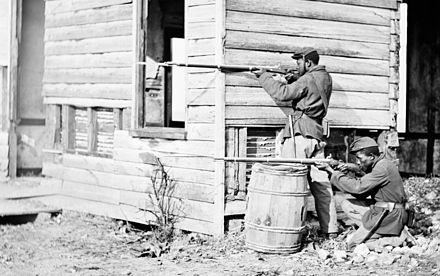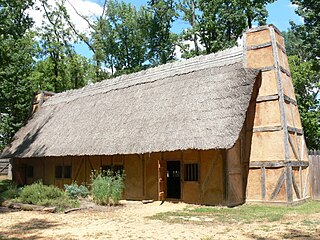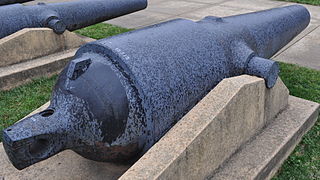
Roanoke Island is an island in Dare County on the Outer Banks of North Carolina, United States. It was named after the historical Roanoke Carolina Algonquian people who inhabited the area in the 16th century at the time of English exploration.

The Battle of New Bern was fought on 14 March 1862, near the city of New Bern, North Carolina, as part of the Burnside Expedition of the American Civil War. The US Army's Coast Division, led by Brigadier General Ambrose Burnside and accompanied by armed vessels from the North Atlantic Blockading Squadron, were opposed by an undermanned and badly trained Confederate force of North Carolina soldiers and militia led by Brigadier General Lawrence O'B. Branch. Although the defenders fought behind breastworks that had been set up before the battle, their line had a weak spot in its center that was exploited by the attacking Federal soldiers. When the center of the line was penetrated, many of the militia broke, forcing a general retreat of the entire Confederate force. General Branch was unable to regain control of his troops until they had retreated to Kinston, more than 30 miles away. New Bern came under Federal control, and remained so for the rest of the war.
Thomas Dowse, also known as Thomas Dawse and Thomas Dawles was an English-American immigrant who represented City of Henricus in the first meeting of the House of Burgesses on July 30, 1619 at Jamestown, Virginia.

The opening phase of what came to be called the Burnside Expedition, the Battle of Roanoke Island was an amphibious operation of the American Civil War, fought on February 7–8, 1862, in the North Carolina Sounds a short distance south of the Virginia border. The attacking force consisted of a flotilla of gunboats of the Union Navy drawn from the North Atlantic Blockading Squadron, commanded by Flag Officer Louis M. Goldsborough, a separate group of gunboats under Union Army control, and an army division led by Brig. Gen. Ambrose Burnside. The defenders were a group of gunboats from the Confederate States Navy, termed the Mosquito Fleet, under Capt. William F. Lynch, and about 2,000 Confederate soldiers commanded locally by Brig. Gen. Henry A. Wise. The defense was augmented by four forts facing on the water approaches to Roanoke Island, and two outlying batteries. At the time of the battle, Wise was hospitalized, so leadership fell to his second in command, Col. Henry M. Shaw.
This article is about the many neighborhoods and districts in the Greater Richmond, Virginia area. Note that this article is an attempt to be inclusive of the broader definitions of the areas which are often considered part of the Greater Richmond Region, based on their urban or suburban character and nature, rather than by strictly political boundaries.

St. John's Church is an Episcopal church located at 2401 East Broad Street in Richmond, Virginia, United States. Formed from several earlier parishes, St. John's is the oldest church in the city of Richmond, Virginia. It was built in 1741 by William Randolph's son, Colonel Richard Randolph; the Church Hill district was named for it. It was the site of two important conventions in the period leading to the American Revolutionary War, and is famous as the location where Patrick Henry gave his memorable speech at the Second Virginia Convention, closing with the often-quoted demand, "give me liberty, or give me death!" The church is designated as a National Historic Landmark.
Varina is a former unincorporated community and current magisterial district in the easternmost portion of Henrico County, Virginia, United States.

Westham Bridge crossed the James River between Henrico County and Chesterfield County. The bridge was located between Bosher Dam and Williams Island Dam just west of the 7 miles of rapids and falls which constitute the fall line of the James River at Richmond, Virginia.

Fort Raleigh National Historic Site preserves the location of Roanoke Colony, the first English settlement in the present-day United States. The site was preserved for its national significance in relation to the founding of the first English settlement in North America in 1587. The colony, which was promoted and backed by entrepreneurs led by Englishman Sir Walter Raleigh, failed sometime between 1587 and 1590 when supply ships failed to arrive on time. When next visited, the settlement was abandoned with no survivors found. The fate of the "Lost Colony" remains a mystery.

John Gray Foster was a career military officer in the United States Army and a Union general during the American Civil War whose most distinguished services were in North and South Carolina. A postbellum expert in underwater demolition, he wrote the definitive treatise on the subject in 1869. He continued with the Army after the war, using his expertise as assistant to the Chief Engineer in Washington, DC and at a post on Lake Erie.
Contraband was a term commonly used in the United States military during the American Civil War to describe a new status for certain escaped slaves or those who affiliated with Union forces. In August 1861, the Union Army determined that the US would no longer return escaped slaves who went to Union lines and classified them as "contraband of war", or captured enemy property. They used many as laborers to support Union efforts and soon began to pay them wages. The former slaves set up camps near Union forces, and the Army helped support and educate both adults and children among the refugees. Thousands of men from these camps enlisted in the United States Colored Troops when recruitment started in 1863. At war's end, more than 100 contraband camps existed in the South, including the Freedmen's Colony of Roanoke Island, where 3500 former slaves worked to develop a self-sufficient community.
Henrico City was one of four incorporations established in the Virginia Colony in 1619 North America by the proprietor, the Virginia Company. The plantations and developments were divided into four "incorporations" or "citties", as they were called. These were Charles City, Elizabeth City, Henrico City, and James City. The latter included the seat of government for the colony at Jamestown. Each of the four citties extended across the James River, the main conduit of transportation of the era.
The Arrohattoc, also occasionally spelled Arrohateck, was a Native American tribe from Henrico County, Virginia in the United States. The tribe was led by their chief Ashuaquid and was part of the Powhatan Confederacy. Their main village was located on the James River, the location of which is now the site of Henrico, Virginia.






















